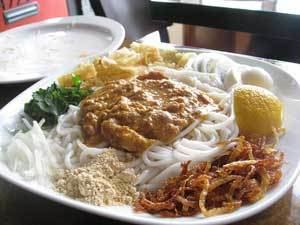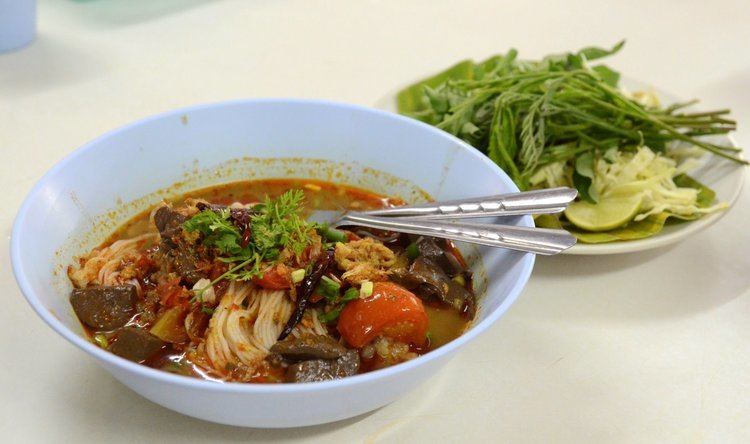Type Rice noodles Main ingredients Rice Main ingredient Rice | Place of origin Thailand | |
 | ||
Similar | ||
Thai fish curry recipe khanom jeen nam ya
Khanom chin (Thai: ขนมจีน, [kʰà.nǒm t͡ɕīːn]; also spelled khanohm jeen) are fresh, thin rice noodles in Thai cuisine which are made from rice sometimes fermented for three days, boiled, and then made into noodles by extruding the resulting dough through a sieve into boiling water. Khanom chin is served in many kinds of stock: coconut milk, fish curry, and chilli. Although chin means "Chinese" in Thai, this type of noodle originated from the Mon people who inhabited the region which is now central Thailand before the arrival of the Thai people from southern China. The word khanom chin is probably derived from the Mon words khohn ohm jin, meaning "twice boiled".
Contents

These noodles are used as a staple food in a variety of Thai dishes. Some popular dishes are:
Another popular combination is to serve Thai papaya salad together with this noodle.
There are two types of khanom chin noodles:

Similar noodles are also found in other cuisines: mi xian is from Yunnan Province, China; num banh chok from Cambodia; and bún from Vietnam.

Eating khanom chin
When khanom chin is served, stock is added. Each locality has a different stock such as coconut stock, fish, curry sauce, chili sauce, and curry with coconut milk such as green curry, spicy pork sauce, and fish organ sour soup. Moreover, for children there is also a sweet stock without spices combined with nuts.
Kanom chin is eaten with fresh vegetables and pickles as condiments. In the north, pickled cabbage and raw sprouts are typical. In the central region, banana blossoms, lentils, cucumbers, sprouts, raw papaya, basil, guto kola, bitter melon, and morning glory. Another condiment is half-boiled egg and roasted peppers. In the northeast, fresh vegetables such as white popinac, climbing wattle, and parsley. In the south, fresh vegetables such as parkia, white popinac, olives, and pickles.
Variations
Khao poon also called Lao laksa, kapoon, and khao pun. Khao poon is a popular type of spicy Lao "rice vermicelli" (rice noodles, sticky rice) soup from Laos. Khao poon is available in Thailand, Indonesia, Singapore, and the United States. The main ingredients of khao poon are minced chicken, fish, or pork and seasoned Lao ingredients, for example fish sauce, lime leaves, galangal, garlic, shallots, Lao chilies, and perilla. Khao poon usually in two versions which are "khao poon nam prik" (with coconut milk) and "khao poon nam jaew" (without coconut milk). Khao poon is always served with shredded cabbage, carrots, and banana blossoms with bean sprouts.
Mohinga is a rice noodle and fish soup from Myanmar which is usually served for breakfast. The main ingredients of mohinga are catfish, chickpea flour, vermicelli noodle, fish sauce, fish pate, ginger, banana stem, lemongrass, onions, garlic, and chickpea flour. It is an essential part of Myanmar cuisine. Fish used for making stock is often fried and added to the soup upon serving.
Bún chả is a Vietnamese dish of grilled pork and noodles which is originally from Hanoi. The main ingredients of bun cha are rice vermicelli, grilled pork, and fresh herbs. Bun cha is served with white noodles, grilled fatty pork, and herbs as a side dish.
